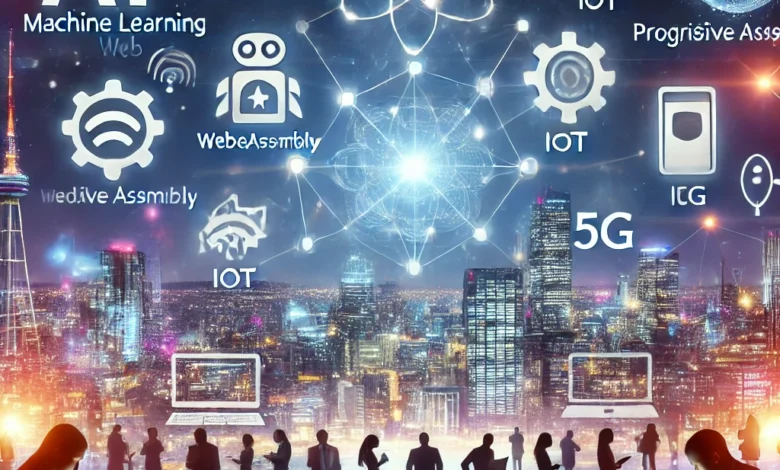The Future of Web Technologies: Empowering Innovation and Connectivity

Introduction
The world of web technologies is a dynamic and ever-evolving landscape that has profoundly shaped how we interact, communicate, and do business in the digital age. From the early days of static web pages to today’s rich, interactive experiences, web technologies have come a long way, fueling innovation and transforming industries across the globe. As we look toward the future, the potential for web technologies to further revolutionize our world is both exciting and boundless.
In this blog, we will explore the evolution of web technologies, the role they play in fostering connectivity, and the emerging trends that promise to shape the future. Our journey will highlight the positive impact these technologies have had on society and the incredible opportunities they continue to create. Whether you’re a seasoned developer, a business owner, or simply a tech enthusiast, there’s never been a better time to embrace the power and potential of web technologies. The future is bright, and the possibilities are endless.
The Evolution of Web Technologies
The evolution of web technologies has been nothing short of remarkable. In the early days of the internet, websites were primarily static, consisting of basic HTML structures that offered limited functionality and interactivity. However, as the internet began to grow, so did the demand for more engaging and dynamic web experiences. This demand gave rise to CSS (Cascading Style Sheets), which allowed developers to separate content from design, making websites not only functional but also visually appealing.
The introduction of JavaScript marked a significant milestone in the evolution of web technologies. JavaScript brought interactivity to the web, enabling developers to create dynamic content that could respond to user input in real-time. This laid the groundwork for the development of sophisticated web applications and the rise of frameworks and libraries such as jQuery, Angular, React, and Vue.js, which have since become essential tools in modern web development.
As these technologies have matured, they have transformed the web into a platform capable of delivering rich, immersive experiences that rival those of native desktop applications. The impact on user experience has been profound, with websites becoming more accessible, intuitive, and responsive. The evolution of web technologies has not only enhanced the way we interact with the internet but has also democratized access to information, empowering individuals and businesses alike to thrive in the digital era.
To know FAQs about spanning web technologies, visit https://dinogeek.me/
Modern Web Technologies: A Catalyst for Innovation
Modern web technologies have proven to be a powerful catalyst for innovation, enabling the development of cutting-edge solutions that address complex challenges across various industries. One of the most transformative advancements in recent years has been the integration of Artificial Intelligence (AI) and Machine Learning (ML) into web applications. These technologies have opened new avenues for creating personalized, data-driven experiences that adapt to user needs in real-time.
For example, AI-powered chatbots and virtual assistants are now commonplace on websites, providing instant customer support and enhancing user engagement. In e-commerce, AI-driven recommendation engines analyze user behavior to offer personalized product suggestions, driving sales and improving customer satisfaction. Similarly, in healthcare, web technologies are being used to develop telemedicine platforms that leverage AI to provide accurate diagnostics and treatment recommendations, making healthcare more accessible and efficient.
Another significant development in modern web technologies is the emergence of WebAssembly, a powerful tool that allows developers to run high-performance applications in the browser. WebAssembly bridges the gap between native and web applications, enabling developers to build complex software, such as games and simulations, that can run seamlessly in a browser environment. This has expanded the possibilities for what can be achieved on the web, making it a more versatile platform for innovation.
Real-world examples of these innovations are abundant. In education, web-based platforms powered by AI are providing personalized learning experiences that cater to individual students’ needs, helping to close the achievement gap. In the automotive industry, connected vehicles are using web technologies to communicate with each other and with infrastructure, paving the way for safer, more efficient transportation systems.
The impact of modern web technologies extends beyond individual industries, fostering a culture of innovation that drives progress across the board. By empowering developers to push the boundaries of what is possible, these technologies are helping to create a more connected, efficient, and innovative world.
The Importance of Connectivity
In today’s globalized world, connectivity is more crucial than ever. Web technologies play a pivotal role in enhancing connectivity, breaking down geographical barriers, and bringing people closer together. Through the internet, individuals and businesses can communicate, collaborate, and share information instantly, regardless of their location.
One of the most significant contributions of web technologies to connectivity is their ability to bridge the digital divide. In many parts of the world, access to the internet was once limited to those in urban areas or with significant financial resources. However, advances in web technologies, coupled with efforts to expand internet infrastructure, have made it possible for even the most remote communities to connect to the global network.
This increased connectivity has had profound positive outcomes. For individuals, it means access to a wealth of information, educational resources, and economic opportunities that were previously out of reach. For businesses, it opens up new markets, enabling them to reach customers around the world and operate on a global scale. Moreover, the ability to connect and collaborate online has fostered inclusivity, allowing diverse voices and perspectives to be heard and valued.
The power of web technologies to enhance connectivity is perhaps best exemplified by the rise of social media platforms, which have transformed the way we communicate and build relationships. These platforms enable people to stay connected with friends and family, join communities of like-minded individuals, and participate in global conversations. In doing so, they have helped to create a more interconnected and understanding world.
Emerging Trends in Web Technologies
As we look to the future, several emerging trends in web technologies are poised to revolutionize the way we interact with the digital world. Among the most exciting of these trends are Progressive Web Apps (PWAs), the Internet of Things (IoT), and the rollout of 5G networks.
Progressive Web Apps represent a significant advancement in web development, combining the best features of both web and native applications. PWAs are designed to be fast, reliable, and engaging, even in areas with poor internet connectivity. They offer offline functionality, push notifications, and a seamless user experience across devices, making them an attractive option for businesses looking to enhance their digital presence. As more companies adopt PWAs, we can expect to see a shift towards a more app-like web experience that prioritizes speed and user engagement.
The Internet of Things is another trend that is set to reshape our interaction with the web. IoT refers to the network of interconnected devices that communicate with each other and with central servers to collect and exchange data. This technology has the potential to revolutionize industries such as healthcare, agriculture, and manufacturing by enabling real-time monitoring and automation of processes. For consumers, IoT promises to bring about a new era of smart homes, where everything from thermostats to refrigerators is connected and controllable via the web.
The rollout of 5G networks is the final piece of the puzzle, providing the high-speed, low-latency connectivity needed to support these emerging technologies. With 5G, we can expect faster download and upload speeds, more reliable connections, and the ability to connect a vast number of devices simultaneously. This will not only enhance the performance of existing web applications but also pave the way for new innovations that require ultra-fast, reliable connectivity.
The convergence of these trends points to a future where the web is more interactive, intelligent, and integral to our daily lives. As these technologies continue to develop, they will unlock new possibilities for innovation and create a more connected, efficient, and responsive digital world.
The Role of Web Developers in Shaping the Future
Web developers are at the forefront of shaping the future of web technologies. Their work is critical in bringing new ideas to life and ensuring that the web remains a dynamic and accessible platform for all. As the web continues to evolve, developers will play an increasingly important role in driving innovation and adapting to new challenges.
The key to success in this rapidly changing landscape is a willingness to embrace new tools and approaches. By staying informed about emerging trends and continuously updating their skills, developers can position themselves at the cutting edge of the industry. This not only opens up exciting career opportunities but also allows them to contribute meaningfully to the advancement of web technologies.
As we look to the future, the outlook for web development is incredibly positive. The demand for skilled developers continues to grow, driven by the ongoing digital transformation of industries worldwide. For those passionate about technology and innovation, web development offers a rewarding and impactful career path with limitless potential.
Conclusion
In conclusion, the evolution of web technologies has had a transformative impact on our world, driving innovation, enhancing connectivity, and creating new opportunities for individuals and businesses alike. From the early days of static web pages to the sophisticated, dynamic applications of today, the web has come a long way, and its potential for future growth is immense.
As we continue to explore the possibilities of modern web technologies, such as AI, ML, WebAssembly, PWAs, IoT, and 5G, we can look forward to a future where the web is more powerful, accessible, and inclusive than ever before. The positive impact of these technologies on our lives is undeniable, and the opportunities they create are boundless.
For web developers, this is an exciting time to be in the industry. By embracing new tools and staying ahead of emerging trends, they can play a crucial role in shaping the future of the web. The journey of web technologies is far from over, and as we move forward, the possibilities are endless. The future is bright, and the web will continue to be a driving force for innovation and connectivity in our increasingly digital world.



